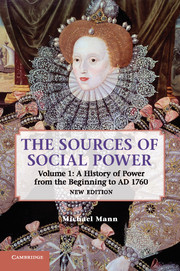Book contents
- Frontmatter
- Contents
- Preface to the new edition
- Preface
- 1 Societies as organized power networks
- 2 The end of general social evolution: how prehistoric peoples evaded power
- 3 The emergence of stratification, states, and multi-power-actor civilization in Mesopotamia
- 4 A comparative analysis of the emergence of stratification, states, and multi-power-actor civilizations
- 5 The first empires of domination: the dialectics of compulsory cooperation
- 6 “Indo-Europeans” and iron: expanding, diversified power networks
- 7 Phoenicians and Greeks: decentralized multi-power-actor civilizations
- 8 Revitalized empires of domination: Assyria and Persia
- 9 The Roman territorial empire
- 10 Ideology transcendent: the Christian ecumene
- 11 A comparative excursus into the world religions: Confucianism, Islam, and (especially) Hindu caste
- 12 The European dynamic: I. The intensive phase, a.d. 800–1155
- 13 The European dynamic: II. The rise of coordinating states, 1155–1477
- 14 The European dynamic: III. International capitalism and organic national states, 1477–1760
- 15 European conclusions: explaining European dynamism – capitalism, Christendom, and states
- 16 Patterns of world-historical development in agrarian societies
- Index
- References
13 - The European dynamic: II. The rise of coordinating states, 1155–1477
Published online by Cambridge University Press: 05 July 2013
- Frontmatter
- Contents
- Preface to the new edition
- Preface
- 1 Societies as organized power networks
- 2 The end of general social evolution: how prehistoric peoples evaded power
- 3 The emergence of stratification, states, and multi-power-actor civilization in Mesopotamia
- 4 A comparative analysis of the emergence of stratification, states, and multi-power-actor civilizations
- 5 The first empires of domination: the dialectics of compulsory cooperation
- 6 “Indo-Europeans” and iron: expanding, diversified power networks
- 7 Phoenicians and Greeks: decentralized multi-power-actor civilizations
- 8 Revitalized empires of domination: Assyria and Persia
- 9 The Roman territorial empire
- 10 Ideology transcendent: the Christian ecumene
- 11 A comparative excursus into the world religions: Confucianism, Islam, and (especially) Hindu caste
- 12 The European dynamic: I. The intensive phase, a.d. 800–1155
- 13 The European dynamic: II. The rise of coordinating states, 1155–1477
- 14 The European dynamic: III. International capitalism and organic national states, 1477–1760
- 15 European conclusions: explaining European dynamism – capitalism, Christendom, and states
- 16 Patterns of world-historical development in agrarian societies
- Index
- References
Summary
In the late twelfth century the multiple, acephalous federation described in the preceding chapter began a long collapse. Eventually, by 1815, western European power networks had taken a different form: a segmentary series of quasi-unitary networks, spreading over the entire globe. The units were the major “national” states and their colonies and spheres of influence. This chapter explains the beginnings of their rise and their interpenetration with the dynamic forces described in the preceding chapter.
I describe two main phases. In the first, discussed in this chapter, a mixture of economic, military, and ideological forces pushed into prominence a set of “co-ordinated,” centralized, territorial states. Central states (normally monarchies), pushing outward from their core role as guarantor of rights and privileges, gradually coordinated some of the main activities of their territories. Local and transnational forms of Christian and “feudal” regulation declined in the face of national political regulation. But the degree of local autonomy remained considerable, so the “real” political constitution was still a form of territorial federalism, cemented by particularistic, often dynastic relations between monarch and semiautonomous lords. I take this phase up to 1477, a significant date not for English history but because it saw the collapse of the last great alternative “feudal” state, the duchy of Burgundy. In the second phase, reserved for the next chapter, these territorially centered relationships began to take an “organic” form in which the state was the centralized organizer of a ruling class.
- Type
- Chapter
- Information
- The Sources of Social Power , pp. 416 - 449Publisher: Cambridge University PressPrint publication year: 2012



